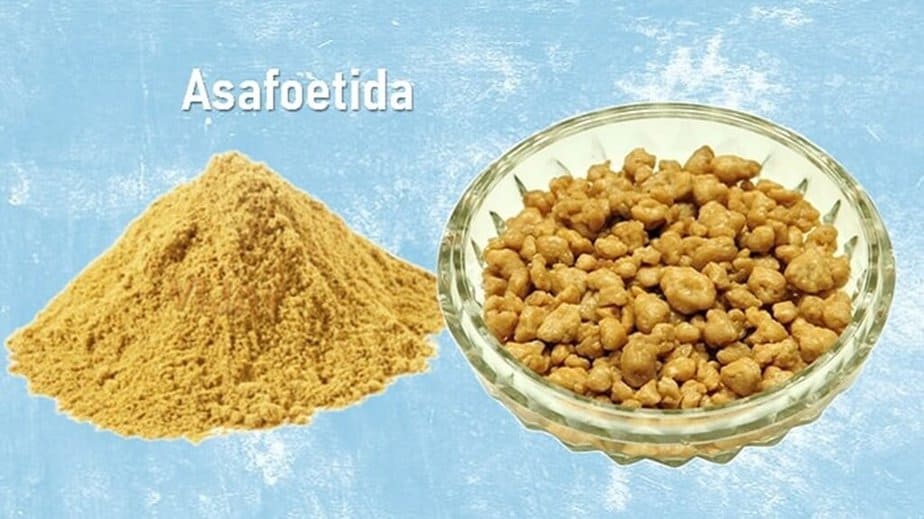Asafoetida (hing) may not be a familiar cooking ingredient for many, especially in the Western world. However, it is used, mainly in Indian cooking, not only as a flavoring agent but also for its many health benefits. Undoubtedly, it’s an excellent spice ingredient that aids in digestion with several other promising activities beneficial to health.
Don’t worry if you don’t have asafetida/hing for a recipe that requires it. In this article, you’ll read about the best asafetida substitutes that you can easily find and use.
What is Asafoetida?
Asafetida, also known as hing, is the dried latex exuded from the rhizome or tap root of several species of Ferula. They are part of the celery family of herbs.
Asafoetida resin is produced by solidifying juice that comes out of cuts made in the plant’s living roots. The resin appears grayish-white when fresh, darkening with age to yellow, red, and eventually brown.
You get to buy it as a fine yellow powder. Also, it is available in lumps/blocks and sometimes in crystalline or granulated form.
In Latin, hing is nicknamed ‘stinking gum’ for its pungent smell of rotting onions or sulfur when raw. It is sometimes called “devil’s dung.”
After cooking, the sulfur smell of this spice dissipates and adds an onion-like flavor to the dish.
Usually, the asafetida powder is used for flavoring vegetable dishes. In Indian cooking, it is a preferred substitute for garlic and onions, which are harsher on the digestive system.
Asafoetida Benefits And Uses
Asafoetida (Ferula asafoetida) has been consumed as a spice and folk medicine for centuries and is a popular ingredient used in Indian cooking.
Asafoetida powder is a staple ingredient in many Indian cuisines, an excellent compliment to other common spices like ginger and cumin.
On the medicinal front, it’s an effective digestive aid and reduces flatulence.
If raw garlic or onion is causing any digestive issues, use asafetida as a substitute to resolve the issue.
Natural therapists say that this can help with the symptoms of irritable bowel syndrome.
Other expected benefits are:
- Asthma.
- Bronchitis.
- Hysteria.
- Intestinal gas.
- Convulsions.
- Menstrual problems.
- Nerve disorders.
- Corns and calluses.
- Irritable colon.
- Stomach upset.
- Other conditions.
Note that more evidence is needed to confirm the actual effectiveness of asafoetida on these issues.
Best Substitutes For Asafoetida
Choosing an asafetida substitute is necessary when you don’t have it while cooking a recipe that requires it. Here are a few suitable replacements for this:
1. Onion and garlic powder
Asafoetida tastes like the flavor we get from a combination of onion and garlic. So, the best ingredient that you can use in place of asafoetida is a blend of garlic and onion powder. Use this blend in a 1:1 ratio as a substitution for asafoetida.
Make a blend of 1/4 teaspoon onion powder plus 1/4 teaspoon minced garlic to substitute ½ teaspoon hing.
This substitute may not be a good choice for people who have digestive issues with garlic or onion.
If you don’t have onion powder, you can use onion paste as a substitute for asafoetida. If a recipe calls for one teaspoon of asafoetida, use one teaspoon of onion powder instead.
2. Leeks and fresh garlic
Leeks appear like large scallions. These larger green-topped onions come with a milder flavor.
A mixture of leeks and fresh garlic can bring in a similar flavor of asafoetida in your recipes. Use equal amounts of leaves and fresh garlic to prepare the mixture.
Leeks render the flavor of onion, and fresh garlic provides the pungency that your recipe otherwise derives from hing.
For the best flavor, sauté the garlic and leeks in ghee (clarified butter) before adding them to your dishes.
3. Chives
Chives are a species of flowering plant in the family Amaryllidaceae that produces edible leaves and flowers. This plant is closely related to onions and garlic. With its onion-like flavor, it can be eaten cooked or raw and is mainly used in soups, salads, or some vegetable dishes.
There are different types of chives, like garlic chives and giant Siberian chives. It has a mild onion-like flavor to complement the garlic flavor.
In de facto, garlic chives very well resemble the flavor of asafoetida. While substituting, use chives in a little more quantity than asafoetida.
If you don’t have chives, you may opt for fennel. Fennel is a bit sweeter than asafoetida but is still a great substitute that works well in most recipes.
4. Shallots
Shallots are a member of the allium family of plants, closely related to onions, chives, and garlic.
Shallots have a mild flavor of onion and a hint of garlic. Its flavor is somewhat similar to leeks. For this reason, it is a worthy replacement for asafoetida, which has a combined flavor of garlic and onion.
Use shallots in place of asafoetida as much as the garlic or leeks you use. For the best effects, chop and sauté the shallots in clarified butter or vegetable oil.
The Bottom Line
While cooking, if you don’t have asafoetida that is required, then use its substitute. Fortunately, all the best asafoetida substitutes that I have listed you might already have on your kitchen shelf.
I recommend using a blend of onion and garlic in equal portions as the best ingredient to use in place of asafoetida powder or hing.
Related articles:
